Latest update 1 February 2011
In some publications headsets and earphones are described as "high impedance" or "low impedance", but in relation to what? It was especially confusing with the HS-38/HS-38A headset in the early P-series helmets. To begin with they were described as "low impedance" and later as "high impedance". When I finally succeeded in digging out some figures it all made sense. Here goes (everything relates to USAAF/USAF standards):
HS-18:
The early WW2 standard headset used in helmets was the HS-18 with R-14 earphones. It had
an impedance of approx. 4000 ohms (Sources
disagree on this but my figure is based on the fact that the MC-385(*) adapter, that was
used as an interface between a high impedance aircraft comms installation and a low
impedance HS-33 headset converted from approx 3750 ohms to 600 ohms). As far as I have been able to tell, this is the first USAAF
headset that was installed in a flight helmet. Used with helmets like AN-H-15, A-10A, A-11
and AN-H-16. This headset was also used in tank helmets.
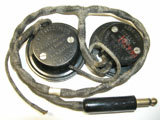
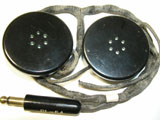
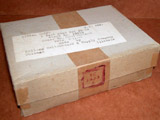
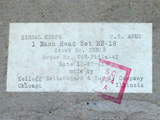
Far left and Left: HS-18
headset, factory-fresh and ready to install in a helmet. It is easy to distinguish from
the
later HS-33 headset by the black PL-54 jack. Right and Far
right: HS-18 headset still in its original box as it left
the factory in 1942. Pictures © Georges and René Jean
HS-23:
HS-23 is functionally similar to the HS-18 headset but equipped with a headband for
non-helmet applications. It used the HB-7 headband and was equipped with R-14 earphones.
Like the HS-18 it had an impedance of approximately 4000 ohms. Both the HS-18 and HS-23
were equipped with a brown braided comm cord with a black PL-54 jack plug.
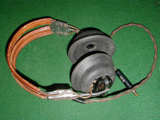
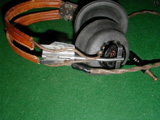
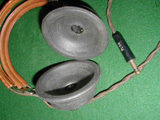
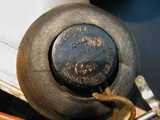
HS-23 headset. The HB-7 headband on this particular headset
has been modified by bending the two metal plates
below the leather-covered bands inwards approximately 20 degrees. This modification was
implemented in the
manufacturing process after WWII and constituted one of the distinguishing features betwen
the HS-33 and the
HS-33A headsets (se below). This headset is therefore either modified by its user or a
later reconstruction using
early R-14 receivers on an HS-33A headband. Pictures © G.M.Bell Bell's Aviation
-----------------------------------IMPEDANCE CHANGE-----------------------------------
HS-33, HS-33A:
Around 1943 a so-called "low impedance" headset was introduced based on the
ANB-H-1 earphone with an impedance of "only" 600 ohms. The proper headset
version was designated HS-33. For a period the HS-23 and HS-33 headsets were used in
parallel and in order not to confuse one from the other the HS-23 was equipped with a
black PL-54 jack and the HS-33 with a red PL-354 jack. It was possible to use the low
impedance HS-33 in a high impedance aircraft comms installation by connecting through an
MC-385-(*) adapter. The HS-33 headset was used into the 1950s and the associated aircraft
intercom systems were designated AIC-2 or AIC-3. The HS-33A headset is a postwar version
and differed from the HS-33 by having chamois-covered NAF-48490-1 ear cushions instead of
the earlier full rubber ear cushions, and the headband had two bends to make it more
stable on the wearer's head.
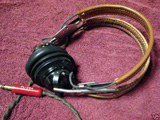
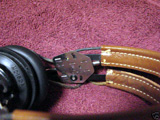
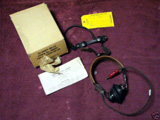
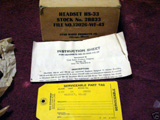
Far left: HS-33 headset with its red PL-354
jack. Left: The headband anchor plates are NOT bent inwards, identifying this as an original early HS-33 headset. Right: HS-33 headset
together with its original box and a T-30 throat
microphone. Far right: Original box, instructions and supply tag.
Pictures © savarese29
HS-38:
HS-38 was the helmet version of the HS-33 headset. Used with helmets like AN-H-15, A-10A,
A-11 and AN-H-16. It was also used in the early USAAF jet helmet prototypes
preceding the P-1 helmet.
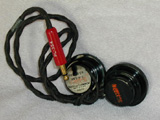
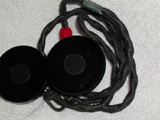
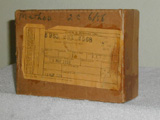
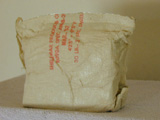
Far left and Left:
Factory-fresh HS-38 headset. Right and Far right: HS-38
headset still in its box and its inner
package, concealed against moisture and dust. Pictures © Bluelight
HS-38A:
No documentation has been found describing the exact configuration of the HS-38A headset.
It is my assumption that the HS-38A headset is the one that is usually found in P-1, P-1A, P-1B and P-3 helmets. It differs from the HS-38 in having a female
microphone plug for mounting on the left side of the helmet and a combined plug, the
U-75/U, which carries the signals for both receivers and for the microphone. Prior to the
advent of the HS-38A pilots had to plug in the receivers via the helmet comm cord and the
microphone through a separate comm cord from the oxygen mask.
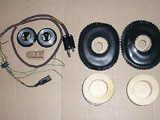
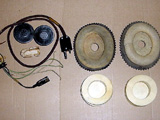
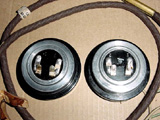
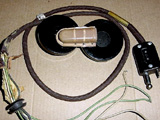
Far left and Left: The
parts that are believed to constitute an HS-38A headset. Right: The
receivers appear to be
a modified version of the ANB-H-1 receiver used in the HS-33 and HS-38 headsets but the
designation is unknown
to me. Far right: Close-up of the comm cord, receivers, and the rubber
boot holding the female microphone plug
to the helmet shell. Pictures © Alan Masengale
H-46/UR, H-46A/UR:
The H-46/UR and H-46A/UR headset-microphones are HS-33A headsets equipped with a boom
microphone. H-46/UR is equipped with an M-3/A boom microphone and H-46A/UR with an M-3A/A
boom microphone. The two boom mikes differ by the first one having a latex rubber
microphone cover and PL-291 plug, whereas the latter has a polyethylene strip mike cover
and PL-292 plug.
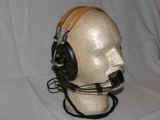
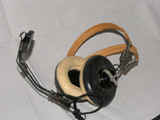
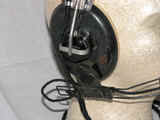
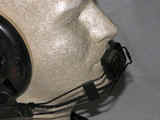
H-46A/UR headset with M-3A/A boom microphone. The microphone element itself is designated
M-6A/UR. All pictures
are thumbnails. Pictures © Bluelight
-----------------------------------IMPEDANCE CHANGE-----------------------------------
In 1953 the USAF adopted a new standard for aircraft intercom systems with the introduction of the AN/AIC-10 and later AIC-18 intercom systems. The new headsets installed from P-4 helmets and retrofit in earlier helmets was only 9,5 ohms with a 5 ohms microphone, and suddenly the earlier "low" impedance headsets like the HS-38/HS-38A had become "high impedance". The standard introduced in 1953 is is still the USAF standard today so technically it would be possible to use e.g. a P-4 helmet in an F-16.
H-70()/AIC:
This is the designation of the H-78/AIC headset (see below) when it is not fitted with a
boom microphone.
H-71/AIC:
Basically the H-75/AIC headset without 'tophat' spring mounts. Used for soft
helmets like the A-13.
H-75()/AIC:
H-75 came in four versions, H-75/AIC, H-75A/AIC, H-75B/AIC and H-75C/AIC. From what I have
been able to ascertain only the three first were used in P-4 and P-4A helmets while
H-75C/AIC was used in the US Army helmet APH-5A. The earphone element used in H-75
headsets is the H-79/AIC (H-143/AIC in the C-version). Two types of 'tophat' spring mounts
were used. The early one had a metal flange for attaching the earpad, metal brackets for
attaching the headset drawstrings and fixed mounting holes for shell attachment screws.
The late version had a black plastic flange with integral holes for drawstring attachment
and the bottom had two U-shaped holes that allowed the entire 'tophat' spring mount to be
adjusted through 90 degrees while attached to the helmet shell. This allowed a better
adjustment for individual pilot needs.
As far as I have been able to determine by studying actual headsets (no documentation
available) the specific differences are:
| Headset type | Earphones | Jack plug | Earpads | 'Tophat' spring mount |
| H-75/AIC | H-79/AIC | U-93/U | soft rubber-covered | fixed |
| H-75A/AIC | H-79/AIC | U-93A/U | soft rubber-covered | fixed |
| H-75B/AIC | H-79/AIC | U-93A/U | MX-2088/U | fixed |
| H-75C/AIC | H-143/AIC | U-93A/U | MX-2088/U | adjustable |
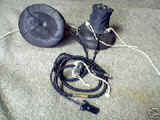
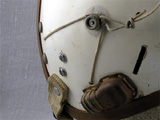
Left: H-75A/AIC headset with the soft
rubber-covered earpads of unknown designation. Later versions had MX-2088/U earpads.
Right: Close-up of a P-4 helmet with H-75/AIC headset. The two screws
over the chin strap hold the headset to the helmet shell.
The nylon drawstrings are fixed over the rubber studs to pull the headset away from the
wearer's ears for putting the helmet on
and taking it off. When the helmet is positioned correctly on the wearer's head the string
is released and the spring mounts press
the earphones against the wearer's ears.
H-78()/AIC:
The H-78/AIC headset was introduced around the same time as the H-75 helmet headset for
use in aircraft equipped with the AIC-10 intercom system. Like the H-75 it uses the
H-79/AIC earphone element (except the H-78C/AIC which uses the H-143/AIC). The boom mike
used on H-78()/AIC is the M-33/AIC or M-33A/AIC that can also be found as helmet mounted.
Earpads are MX-2088/U like on H-75B/AIC and H-75C/AIC. The headset came in four versions
H-78/AIC, H-78A/AIC, H-78B/AIC and H-78C/AIC. The specific differences are:
H-78/AIC: H-79/AIC earphone elements, M-33/AIC microphone, xxx microphone mount, U-93/U
jack plug.
H-78A/AIC: H-79/AIC earphone elements, XXX microphone, xxx microphone mount, U-93A/U jack
plug.
H-78B/AIC: H-79/AIC earphone elements, M-33A/AIC microphone, xxx microphone mount, U-93A/U
jack plug.
H-78C/AIC: H-143/AIC earphone elements, M-33A/AIC microphone, xxx microphone mount,
U-93A/U jack plug.
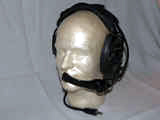
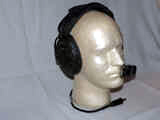
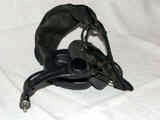
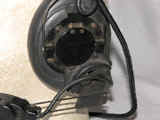
H-149/AIC:
The H-149/AIC headset was introduced around 1959 for use in the P-4B helmet. It
is the main distinguishing feature between a P-4A and a P-4B helmet. It comprises
H-143/AIC earphones, MX-2088/U earpads and a CX-4708/AIC cable. It is the first headset
that leaves the pigtail comm cord principle. Instead the main communication connection is
through the CX-4707/AIC cable on the pilot's oxygen mask. Besides the P-4B, H-149/AIC was
also used in the HGU-2/P helmet and in the HGU-2A/P(G) made especially for the German Air
Force.
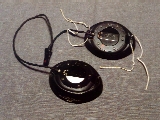
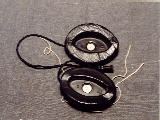
H-154/AIC:
The H-154/AIC headset was introduced in the early 1960s for use in the HGU-2A/P helmet.
Apparently the main improvement over the H-149/AIC headset was the introduction of plastic
earcups with soft earpads that actually enclosed the wearer's ears. This must have given a
better noise attenuation. The mounting on spring loaded arms would also give a better
possibility for adjusting the headset forward and rearward. The H-154/AIC headset was also
used in the HGU-7/P helmet in a version without spring-loaded arms.
According to military specification MIL-H-27467A dated 1 March 1963 a complete H-154/AIC
headset consists of the following items. The text in parentheses is my comments):
- 2 ea. earphone H-143/AIC (often also referred to as receivers)
- 1 ea shell, earphone MX3678/AIC (plastic earcup left side)
- 1 ea shell, earphone MX3679/AIC (plastic earcup right side)
- 2 ea bracket, earphone MT-2621/AIC (spring loaded arms with earcup mounting brackets)
- 1 ea cord assembly, electrical, branched, CX-4707A/AIC (oxygen mask comm cord)
- 1 ea cord assembly, electrical, branched, CX-4708A/AIC (comm cord that connects the
earphones
- 1 ea installation kit, MK-634/AIC ("S-hook"-bracket, cord clips and studs for
holding the strings on the outside of the helmet)
- 2 ea cushion, earphone shell MX-3680/AIC (earpads)
- 2 ea pad assembly, damping (thin foam rubber membrane placed over the H-143/AIC
earphone, inside the earcup)
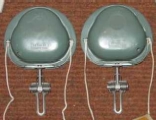
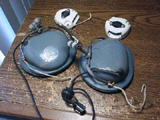
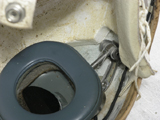
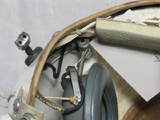
H-154/AIC headset with the typical triangular MX3678 and
MX3679 earcups and spring loaded arms. The two pic-
tures to the right show the how the headset spring arms are installed in an HGU-2A/P
helmet with the same screws
that hold the earcup drawstring on the outside of the helmet shell.
H-154A/AIC:
The H-154A/AIC headset was introduced in the late 1960s for use with helmets based on the
HGU-22 helmet shell. It is still the standard USAF headset for helmet use including in the
HGU-55/P. It is interesting that the H-154A/AIC is still produced with reference to the
H-154/AIC specification (MIL-H-27467A dated 1 March 1963) even if the H-154A/AIC is
significantly upgraded. Instead of the spring loaded arms the H-154A/AIC earcups are
attached to the helmet shell with Velcro and fitted to the individual user with foam
rubber pads of different thickness between the earcup and helmet shell.
A complete H-154A/AIC headset consists of the following items (partly based on the
HGU-26/P T.O. and partly on my own observations):
- 2 ea. earphone H-143/AIC (often also referred to as receivers)
- 2 ea shell, earphone MX8376/AR (plastic earcups)
- 1 ea cord assembly, electrical, branched, coiled CX-4707C/AIC (oxygen mask comm cord)
- 1 ea cord assembly, electrical, branched, CX-4708A/AIC (comm cord that connects the
earphones
- 1 ea installation kit, MK-634/AIC ("S-hook"-bracket, cord clips and studs for
holding the strings on the outside of the helmet)
- 2 ea cushion, earphone shell (e.g. Astrocom 10395B) (earpads)
- 2 ea earphone retainer (slotted foam rubber insert inside the earcup)
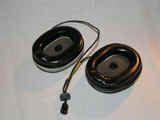
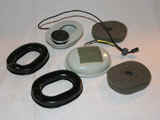
H-157/AIC:
The H-157/AIC headset was introduced in the early 1960s (NSN assigned prior to
January 1st 1962) as a successor to H-78()/AIC because of
its better noise protective qualities. The microphone is an M-87/AIC. The construction of
the headset allows the user to choose freely whether he/she wishes to have the boom
microphone mounted on the left or right side.
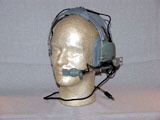
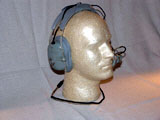
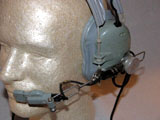
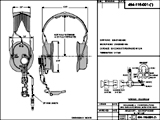
H-157/AIC headset. Pictures are © Bluelight, and the
drawing is © Roanwell Corp.
H-157A/AIC:
NSN assigned March 18th 1982
H-158/AIC:
The H-158/AIC is the designation of the H-157/AIC headset (see above) when it is not
fitted with a boom microphone.
BTW, the term "intercom" is also used in single-seat aircraft even if the pilot
has no other crewmembers to communicate with. The intercom system is used to connect the
transmit/receivers with control boxes and the helmet communications system and in most
aircraft there is also an external plug e.g. in the nose gear well where a crew chief can
plug in his headset to communicate with the pilot during pre-flight inspection.
Cheers, Bluelight